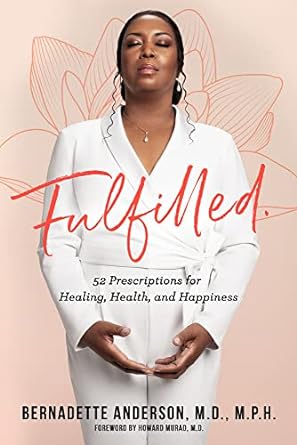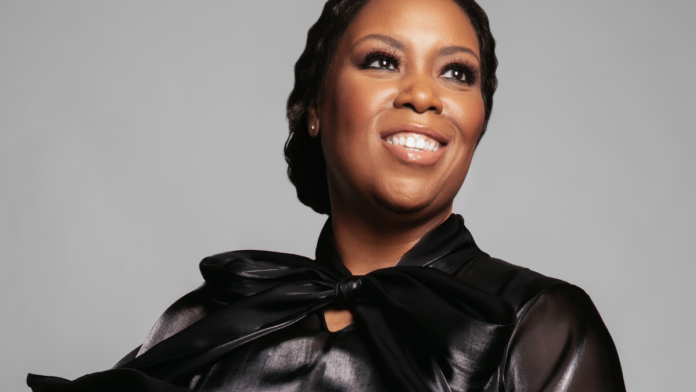( ENSPIRE Health & Wellness ) Dr. Anderson Releases Book “Fulfilled”
ENSPIRE Contributor: Gabrielle Maya
Dr. Bernadette Anderson, MD, MPH, is a Columbus, Ohio, family physician with over two decades of healthcare experience. Her approach to wellness is laying out a bridge between the worlds of holistic and traditional medicine. Dr. Anderson is beginning a new vision for medicine by offering a comprehensive and innovative perspective that caters to all aspects of health and wellness. To kickstart this discovery is through her latest book, “Fulfilled,” which offers 52 actionable insights designed to guide readers on a personalized journey in holistic wellness.
“Fulfilled” presents theoretical insights that individuals can easily apply daily. Personal growth strategies, self-forgiveness, and inner peace empower holistic wellness. Dr. Anderson invites readers to discover their authenticity through reflective exercises and practical, life-tested prescriptions.

Dr. Anderson shares how her family practice began and the benefits of her healthcare practice. Besides learning about her book “Fulfilled,” important points to holistic wellness are finding a balance between holistic medicine and traditional medicine practices. Following up with starting points to achieve inner peace and apply her philosophy.
Please share with us how you began your family practice and transformed your healthcare practice. What are the benefits of your newly discovered healthcare practice?
When I first established my family practice, my primary goal was to deliver evidence-based medical care with precision and dedication. As I immersed myself in the realities of patient care, I discovered that focusing solely on physical symptoms was only part of the solution. Real healing requires addressing the whole person, not just their ailments.
This revelation led me to integrate holistic practices – where science meets the soul – into my approach. Transitioning to include mental wellness in my medical practice was not an easy transition. It required a shift in mindset that isn’t common in medicine, but the benefits far outweighed the challenges. I incorporated mindfulness, emotional support, and lifestyle changes into my practice, seeing each individual as a complex interplay of mind, body, and spirit.
The impact of this transformation has been profound for my patients. They have shared stories of remarkable change—one patient found that mindfulness practices helped her manage chronic pain in ways that medication alone couldn’t, while another discovered that lifestyle adjustments led to a renewed sense of purpose and vitality. By nurturing the mind, body, and spirit, my practice helps individuals recover from illness and embrace a more vibrant and fulfilling life.
They come to understand that their lifestyle choices are integral to their health, and they become empowered participants in their healing journey. This holistic and comprehensive approach shows that when people are supported in whole-self wellness, they achieve not just recovery but a deeper, more meaningful quality of life.
With your book “Fulfilled. 52 Prescriptions for Healing, Health, and Happiness,” what are three important points you mention that can be applied to your daily life?
In my book “Fulfilled,” the 52 chapters are grouped into three main sections, or pillars, that outline a guide for integrating them into daily life:
Healing: This section focuses on the importance of emotional and mental healing. This involves acknowledging and addressing past traumas and emotional wounds. Individuals embark on a journey of self-discovery and recovery by completing the included activities and embracing practices such as journaling, meditation, and seeking support from loved ones or professionals. Beginning with healing allows you to release what no longer serves you so you have space for personal growth.
Health: Another pillar is prioritizing physical health through consistent, sustainable habits. This includes eating a balanced diet, engaging in physical activity at least five times a week, and getting seven to nine hours of sleep nightly. In “Fulfilled,” I highlight how small, manageable changes in daily routines can lead to significant improvements in overall health, and I provide how-to steps to make them a reality.
Happiness: In the last section, I focus on cultivating happiness through positive relationships, purposeful living, and self-compassion. Happiness is not just about fleeting moments of enjoyment but is also about taking action to create a life rich with meaning and fulfillment, and I provide those actionable steps in the book. Connecting with others, laughing out loud, pursuing passions, setting boundaries, and treating yourself with kindness can enhance your daily happiness and build a resilient, joyful life.
How do you balance holistic wellness and traditional medicine that will help people achieve a healthy lifestyle?
Finding harmony between holistic wellness and traditional medicine is like crafting the ultimate health playlist; I like to call it whole-self wellness. Conventional medicine provides evidence-based hits, while holistic practices add a soulful rhythm that nurtures your entire being—mind, body, and spirit. Integrating these approaches is where science truly meets the soul, creating a more meaningful and fulfilling life.
For instance, a doctor might prescribe medication to manage high blood pressure. However, pairing this with holistic practices such as a plant-based diet, mindfulness (or breathing) exercises, and regular walks, movement, or simple stretches can target the root causes and enhance heart health. Similarly, traditional counseling or medication can support mental health. At the same time, holistic practices such as journaling, being present in nature, and practicing gratitude can boost emotional well-being and deepen your connection to yourself and the world.
You might also rely on vaccines and supplements from traditional medicine, but supporting your immune system with natural practices such as adequate sleep and ensuring hydration as well as adding stress management techniques (like aromatherapy), can further enhance overall well-being. This balanced approach empowers you to take intentional steps toward a healthier, more spiritually aware life.

What are some theoretical starting points to achieve inner peace and self-forgiveness?
The journey to inner peace and self-forgiveness starts with the bold decision to permit yourself to release hurts and disappointments. It’s about accepting your imperfections and past mistakes, recognizing that everyone stumbles, and that those moments don’t define your worth.
Inner peace and self-forgiveness involve cultivating self-compassion by treating yourself with the same kindness you’d extend to a close friend—if you wouldn’t berate a friend for a slip-up, why do it to yourself? This shift in attitude softens self-criticism and builds a more forgiving mindset.
Another starting point is to reframe your past experiences by focusing on the lessons learned and the growth achieved. Instead of dwelling on a setback, view it as a stepping stone that reveals your resilience and adaptability. It doesn’t happen overnight, and I have several chapters dedicated to forming healthy habits that allow you to turn regret into wisdom, paving the way for lasting inner peace while building a more compassionate and empowered view of yourself.
My personal P.E.A.C.E. plan (a little sample from the book!) keeps me grounded when life’s challenges start to feel overwhelming:
- P—Pause: Step back from your emotions and the situation to gain clarity and reflect before reacting.
- E—Examine: Consider the situation from all perspectives before drawing conclusions.
- A—Act: Decide what action you can take to address the issue, and if a resolution isn’t possible, be ready to release it.
- C—Change: Focus on what you can change within yourself or your environment to improve the situation.
- E—Exhale: Take a deep breath and let go of the urge to repeatedly replay the issue in your mind.
By following this plan, lasting inner peace and self-forgiveness have become not just aspirations but attainable realities.
What is your philosophy in life, and how has it impacted your writing in “Fulfilled. 52 Prescriptions for Healing, Health, and Happiness” and your healthcare experience thus far?
Regarding the pursuit of wellness, we have two paths: deliberately create the health we desire or passively accept the health we get. While factors like genetics, environment, and culture are influential, the real power to shape our health lies in our choices.
In “Fulfilled. 52 Prescriptions for Healing, Health, and Happiness,” this philosophy comes to life through practical and empowering guidance and actionable steps. The book is designed to empower readers to take charge of their well-being by making conscious, intentional choices.
At the end of each chapter, there is a Prescription—an action-oriented activity that encourages a holistic approach to the chapter topic. Every Prescription is centered around achieving whole-self health, emphasizing that true health is not just about the absence of disease but about thriving with a vibrant mind, resilient body, and deeply fulfilled spirit.
This philosophy in my healthcare practice translates into a proactive care focus. I guide patients to engage with their health and see it as a dynamic aspect of their lives that they can influence. By promoting a proactive mindset, I aim to help them embrace their capacity to champion their health and wellness.
For more information on Dr. Bernadette Anderson’s healthcare practice, visit Central Ohio Primary Care for details. Follow their Instagram for updates and medical resources. Dr Anderson’s book is available on Amazon, Barnes & Nobles, and Studio Creations.
Related Articles: Dr. Sarah Michelle Uses Holistic Treatment for Breast Cancer, Earth’s Own Essentials: Holistic Practices Created by CEO Andrea Bailey-Tweed







